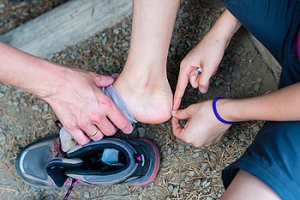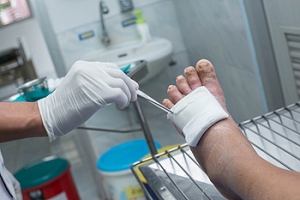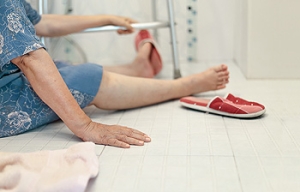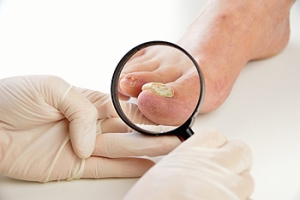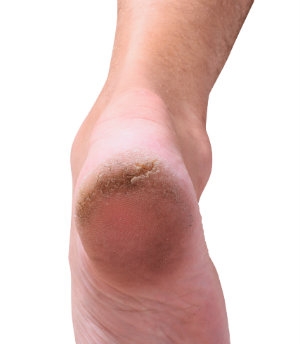
Everything You Need to Know About Gout
Gout, typically found in diabetic patients, is an unusually painful form of arthritis caused by elevated levels of uric acid in the bloodstream. The condition typically strikes the big joint on the big toe. It has also been known to strike the knees, elbows, fingers, ankles and wrists—generally anywhere that has a functioning, moving joint.
The high level of uric acid in a person’s bloodstream creates the condition known as hyperuricema—the main cause of gout. Genetic predisposition occurs in nine out of ten sufferers. The children of parents who suffer gout will have a two in ten chance of developing the condition as well.
This form of arthritis, being particularly painful, is the leftover uric acid crystallizing in the blood stream. The crystallized uric acid then travels to the space between joints where they rub, causing friction when the patient moves. Symptoms include: pain, redness, swelling, and inflammation. Additional side effects may include fatigue and fever, although reports of these effects are very rare. Some patients have reported that pain may intensify when the temperature drops, such as when you sleep.
Most cases of gout are easily diagnosed by a podiatrist’s assessment of the various symptoms. Defined tests can also be performed. A blood test to detect elevated levels of uric acid is often used as well as an x-ray to diagnose visible and chronic gout.
Treatment for gout simply means eliminating symptoms. Non-steroid anti-inflammatory drugs or NSAIDs (Colchicine and other corticosteroid drugs, etc.) will quell the redness, the swelling, and the inflammation. However, managing your diet, lifestyle changes, and using preventative drugs are all helpful toward fully combating the most severe cases.
Those that lead an inactive lifestyle are at a higher risk for gout. Any amount of exercise decreases the probability of repeat encounters with the condition. Reducing your consumption of red meat, sea food, and fructose-sweetened drinks also reduces the likelihood of chronic gout as well.
Ingesting Vitamin C, coffee, and particular dairy products can help with maintaining a healthy lifestyle. There are new drugs out on the market that inhibit the body’s production of uric acid-producing enzymes. However, reducing or eliminating your overall levels of uric acid is the best remedy to ensuring you lead a gout-free life.
What Is a Blister?
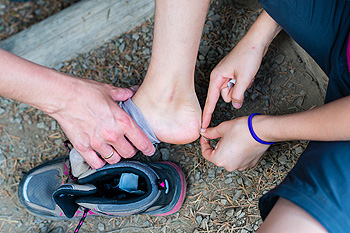 Excessive friction in a specific area of the foot may be a reason for blisters to form. This damages the top layer of the skin and can cause pain and discomfort. They are described as small pockets that are filled with fluid that develop over the affected area. Blisters are considered to be a natural defense mechanism the body produces to promote healing. Additional reasons why blisters may develop can be a result of a sunburn, an allergic reaction to an insect bite, or frostbite. Some patients develop blisters if specific medical conditions exist that may include eczema, chicken pox, or an autoimmune disease. When new skin has formed over the affected area, the majority of blisters will drain naturally. If you would like additional information about how blisters can form on the feet, please speak with a podiatrist.
Excessive friction in a specific area of the foot may be a reason for blisters to form. This damages the top layer of the skin and can cause pain and discomfort. They are described as small pockets that are filled with fluid that develop over the affected area. Blisters are considered to be a natural defense mechanism the body produces to promote healing. Additional reasons why blisters may develop can be a result of a sunburn, an allergic reaction to an insect bite, or frostbite. Some patients develop blisters if specific medical conditions exist that may include eczema, chicken pox, or an autoimmune disease. When new skin has formed over the affected area, the majority of blisters will drain naturally. If you would like additional information about how blisters can form on the feet, please speak with a podiatrist.
Blisters may appear as a single bubble or in a cluster. They can cause a lot of pain and may be filled with pus, blood, or watery serum. If your feet are hurting, contact James P. Huish, DPM of Arizona. Our doctors can provide the care you need to keep you pain-free and on your feet.
Foot Blisters
Foot blisters are often the result of friction. This happens due to the constant rubbing from shoes, which can lead to pain.
What Are Foot Blisters?
A foot blister is a small fluid-filled pocket that forms on the upper-most layer of the skin. Blisters are filled with clear fluid and can lead to blood drainage or pus if the area becomes infected.
Symptoms
(Blister symptoms may vary depending on what is causing them)
- Bubble of skin filled with fluid
- Redness
- Moderate to severe pain
- Itching
Prevention & Treatment
In order to prevent blisters, you should be sure to wear comfortable shoes with socks that cushion your feet and absorb sweat. Breaking a blister open may increase your chances of developing an infection. However, if your blister breaks, you should wash the area with soap and water immediately and then apply a bandage to the affected area. If your blisters cause severe pain it is important that you call your podiatrist right away.
If you have any questions, please feel free to contact our office located in Safford and Sierra Vista, AZ . We offer the newest diagnostic and treatment technologies for all your foot care needs.
Blisters
Blisters are pockets of fluid that occur under the top layer of your skin. These fluid pockets are usually filled with pus, blood, or serum. Blisters may itch or hurt and can appear as a single bubble or in clusters.
The most common types of blisters are friction blisters. This type of blister may be caused by wearing shoes that are too tight. Friction blisters can also occur on the hands. A change in temperature may also cause blisters on the feet. In the freezing air, frostbite on your toes can lead to blisters, as well as sunburn from hot weather.
The best way to treat a blister is to keep it clean and dry. Most blisters will get better on their own. Once the skin absorbs the fluid within the blister, it will flatten and eventually peel off. You should avoid popping your blister unless you podiatrist does it for you. Additional treatment options include applying an ice pack to the blister or using over-the-counter blister bandages to cover the affected area.
If your blister becomes discolored, inflamed, or worsens it is advised that you speak to your podiatrist. Blisters that are yellow, green, or purple may be infected and require immediate medical attention. Blisters that are abnormally colored may be a sign of a more serious underlying health condition such as herpes.
Becoming a Podiatrist
 Many people begin on their paths to becoming podiatrists in their undergraduate years. Students typically major in biology, or another topic in the sciences, to prepare to become a podiatrist. After earning an undergraduate degree, one can attend a podiatry school for four years. Podiatrists do not attend general medical schools, but are still doctors. There are currently nine accredited podiatry schools. Next, students show what they learned during their education with three years of a hospital residency. People need podiatrists for various reasons. These include foot and ankle fractures, deformities, nail complications, diabetes, growing pains and arthritis. If you are interested in the field, contact a podiatrist to learn more.
Many people begin on their paths to becoming podiatrists in their undergraduate years. Students typically major in biology, or another topic in the sciences, to prepare to become a podiatrist. After earning an undergraduate degree, one can attend a podiatry school for four years. Podiatrists do not attend general medical schools, but are still doctors. There are currently nine accredited podiatry schools. Next, students show what they learned during their education with three years of a hospital residency. People need podiatrists for various reasons. These include foot and ankle fractures, deformities, nail complications, diabetes, growing pains and arthritis. If you are interested in the field, contact a podiatrist to learn more.
If you are dealing with pain in your feet and ankles, you may want to seek help from a podiatrist. Feel free to contact James P. Huish, DPM from Arizona. Our doctors can provide the care you need to keep you pain-free and on your feet.
What Is a Podiatrist?
A podiatrist is a doctor of podiatric medicine who diagnoses and treats conditions of the foot, ankle, and related structures of the leg. Your podiatrist may specialize in a certain field such as sports medicine, wound care, pediatrics, and diabetic care. Podiatrists have the ability to become board certified through training, clinical experience, and then taking an exam.
What Do Podiatrists Do?
On a daily basis, a podiatrist may perform the following activities:
- Diagnose foot ailments such as ulcers, tumors, fractures, etc.
- Use innovative methods to treat conditions
- Use corrective orthotics, casts, and strappings to correct deformities
- Correct walking patterns and balance
- Provide individual consultations to patients
It is very important that you take care of your feet. It’s easy to take having healthy feet for granted, however foot problems tend to be among the most common health conditions. Podiatrists can help diagnose and treat a variety of feet related conditions, so it is crucial that you visit one if you need assistance.
If you have any questions please feel free to contact our office located in Safford and Sierra Vista, AZ . We offer the newest diagnostic and treatment technologies for all your foot and ankle needs.
What is a Podiatrist?
A podiatrist is a Doctor of Podiatric Medicine who treats the foot, ankle, and related structures of the leg. If you are having any pain, injuries, or abnormalities in these areas, it is best that you seek help from a podiatrist.
Podiatrists complete four years of training in a podiatric medical school. Their training is like that of other physicians, and they may go on to complete a fellowship training after a residency training. Some podiatrists are board certified meaning they have advanced training, clinical experience, and have taken an exam to prove their skills. Certifying boards for podiatry are the American Board of Foot and Ankle Surgery and the American Board of Podiatric Medicine. Podiatrists may work in private practices, hospitals, clinics, or they may even become professors at colleges of podiatric medicine.
While in college, those who want to be podiatrists often take biology, chemistry, and physics classes in preparation for podiatry school. In podiatry school, students study how the bones, nerves, and muscles work together to help you move around. Additionally, they study injuries and how to properly diagnose and treat them. Admittance into podiatric medical school requires the completion of 90 semester hours of undergraduate study with a good grade point average, and acceptable scores on the MCAT (Medical College Admission Test)
Podiatrists treat many different conditions such as: aching feet, ankle pain, bunions, corns, hammertoes, fungus, ingrown toenails, plantar fasciitis, sprains and more. Common forms of treatment for these conditions are physical therapy, drugs, or surgery. Podiatrists may also recommend corrective shoe inserts, custom-made shoes, plaster casts, and strappings to correct deformities.
Even if you are someone whose feet are in generally good condition, you should still visit a podiatrist to have your feet properly exfoliated and maintained, or to make sure you are looking after your feet properly.
Proper Foot Care Among Elderly People Is Important
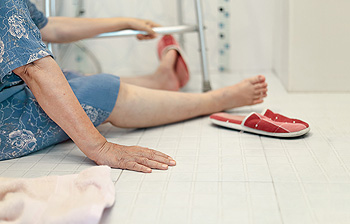 Many elderly people have difficulty in caring for their feet. This is often due to medical conditions that include arthritis, diabetes, or back pain. There are a few tips to keep in mind to assure the feet stay healthy. Research has indicated the importance of wearing shoes that fit properly. This can help to provide adequate support that is needed, and bunions and corns may be prevented. Seniors also tend to have drier skin, which is a result of diminished body fluid as the aging process occurs. An appropriate remedy for dry skin is to apply a moisturizer, preceded by washing and drying the feet thoroughly. Additionally, athlete’s foot may be common among elderly patients, and mild relief may be found in using a medicated foot spray. Another painful condition known as ingrown toenails typically occurs when the nails are trimmed incorrectly. If you have questions about how to care for elderly feet, it is suggested to consult with a podiatrist.
Many elderly people have difficulty in caring for their feet. This is often due to medical conditions that include arthritis, diabetes, or back pain. There are a few tips to keep in mind to assure the feet stay healthy. Research has indicated the importance of wearing shoes that fit properly. This can help to provide adequate support that is needed, and bunions and corns may be prevented. Seniors also tend to have drier skin, which is a result of diminished body fluid as the aging process occurs. An appropriate remedy for dry skin is to apply a moisturizer, preceded by washing and drying the feet thoroughly. Additionally, athlete’s foot may be common among elderly patients, and mild relief may be found in using a medicated foot spray. Another painful condition known as ingrown toenails typically occurs when the nails are trimmed incorrectly. If you have questions about how to care for elderly feet, it is suggested to consult with a podiatrist.
Proper foot care is something many older adults forget to consider. If you have any concerns about your feet and ankles, contact James P. Huish, DPM from Arizona. Our doctors can provide the care you need to keep you pain-free and on your feet.
The Elderly and Their Feet
As we age we start to notice many changes in our body, but the elder population may not notice them right away. Medical conditions may prevent the elderly to take notice of their foot health right away. Poor vision is a lead contributor to not taking action for the elderly.
Common Conditions
- Neuropathy – can reduce feeling in the feet and can hide many life-threatening medical conditions.
- Reduced flexibility – prevents the ability of proper toenail trimming, and foot cleaning. If left untreated, it may lead to further medical issues.
- Foot sores – amongst the older population can be serious before they are discovered. Some of the problematic conditions they may face are:
- Gouging toenails affecting nearby toe
- Shoes that don’t fit properly
- Pressure sores
- Loss of circulation in legs & feet
- Edema & swelling of feet and ankles
Susceptible Infections
Diabetes and poor circulation can cause general loss of sensitivity over the years, turning a simple cut into a serious issue.
If you have any questions please feel free to contact our office located in Safford and Sierra Vista, AZ . We offer the newest diagnostic and treatment technologies for all your foot and ankle needs.
Elderly Foot Care
As you grow older, you will start to notice more problems with your feet due to wear and tear. This may also happen because the skin will start to become thin and lose elasticity. Some signs of aging feet are regular aches and pains, bunion development, and clawed toes.
Fortunately, there are ways you can improve comfort, relieve pain, and maintain mobility in your feet. One of the best ways to deal with aging feet is to exercise. If you keep active, your muscles will become toned which will then strengthen the arches in the foot and stimulate blood circulation.
It is important that you practice proper foot care to protect your aging feet. You should wash your feet in warm water on an everyday basis. Afterward, the feet need to be dried well and it is important to dry between the toes. Your toenails should be trimmed and kept under control; nails that are poorly cut may become ingrown. At the end of each day, performing an inspection of your feet will allow you to detect any ailments in their early stages.
As you grow older, it becomes more important that you wear comfortable shoes. Your shoes should be secure, and they should provide decent arch support. If you are looking to buy a new pair of shoes, it is best to look for a pair that are made from a breathable material. It is also helpful to have shoes that have a bit of extra room at the top of the shoe, especially if you suffer from swollen feet.
The most common foot problems that elderly people will encounter are bunions, calluses, corns, hammertoes, heel pain, and foot problems related to diabetes. Some other issues include arch pain, tarsal tunnel syndrome, Achilles tendonitis, and Morton’s neuroma
An annual foot examination is a great way for you to ensure that you do not have any serious health problems with your feet. You should talk to a podiatrist about the available treatment options for whichever foot issue you are dealing with.
Symptoms of Toenail Fungus
 The medical term for toenail fungus is onychomycosis. This type of fungus typically lives and thrives in warm and moist environments, which often include public swimming pools, locker rooms, and shower room floors. It is considered to be contagious, and appropriate shoes should be worn while in these areas. There may be existing medical conditions that precede the development of toenail fungus. These can include diabetes, a weakened immune system, or a possible skin injury around the nail and surrounding areas. Some of the symptoms that are associated with this condition often include yellow or white streaks on the nail, brittleness of the nail, and some patients may lose the nail. If you notice symptoms of toenail fungus, it is suggested that you speak to a podiatrist who can properly treat this condition.
The medical term for toenail fungus is onychomycosis. This type of fungus typically lives and thrives in warm and moist environments, which often include public swimming pools, locker rooms, and shower room floors. It is considered to be contagious, and appropriate shoes should be worn while in these areas. There may be existing medical conditions that precede the development of toenail fungus. These can include diabetes, a weakened immune system, or a possible skin injury around the nail and surrounding areas. Some of the symptoms that are associated with this condition often include yellow or white streaks on the nail, brittleness of the nail, and some patients may lose the nail. If you notice symptoms of toenail fungus, it is suggested that you speak to a podiatrist who can properly treat this condition.
If left untreated, toenail fungus may spread to other toenails, skin, or even fingernails. If you suspect you have toenail fungus it is important to seek treatment right away. For more information about treatment, contact James P. Huish, DPM of Arizona. Our doctors can provide the care you need to keep you pain-free and on your feet.
Symptoms
- Warped or oddly shaped nails
- Yellowish nails
- Loose/separated nail
- Buildup of bits and pieces of nail fragments under the nail
- Brittle, broken, thickened nail
Treatment
If self-care strategies and over-the-counter medications does not help your fungus, your podiatrist may give you a prescription drug instead. Even if you find relief from your toenail fungus symptoms, you may experience a repeat infection in the future.
Prevention
In order to prevent getting toenail fungus in the future, you should always make sure to wash your feet with soap and water. After washing, it is important to dry your feet thoroughly especially in between the toes. When trimming your toenails, be sure to trim straight across instead of in a rounded shape. It is crucial not to cover up discolored nails with nail polish because that will prevent your nail from being able to “breathe”.
In some cases, surgical procedure may be needed to remove the toenail fungus. Consult with your podiatrist about the best treatment options for your case of toenail fungus.
If you have any questions, please feel free to contact our office located in Safford and Sierra Vista, AZ . We offer the newest diagnostic and treatment technologies for all your foot care needs.
Treating Toenail Fungus
Fungal infection of the toenail, or onychomycosis, typically appears as a gradual change in a toenail’s texture and color that involves brittleness and darkening. The fungal infection itself occurs beneath the surface of the nail. Aside from discoloration, other symptoms include the collection of debris beneath the nail plate, white marks on the nail plate, and a foul odor emanating from the nail. If ignored, the infection can spread into other nails and the skin; in severe cases, it can hinder one’s ability to work or walk.
The toenails are particularly vulnerable to contracting infection in moist environments where people are likely to be walking barefoot, such as around swimming pools, public showers, and locker rooms. Fungal infection may also be more likely to occur in nail beds that have been injured, and sufferers of chronic diseases such as diabetes, circulatory problems, or immunodeficiency conditions are particularly prone to developing fungal nails.
Fungal nails can be primarily prevented by practicing proper hygiene and regularly examining the feet and toes. Carefully washing the feet with soap and water and thoroughly drying the feet afterwards are essential. Other tips include wearing shower shoes in public areas, changing shoes and socks daily, keeping toenails clipped at a short length, wearing breathable shoes that fit properly, wearing moisture-wicking socks, and disinfecting home pedicure tools and instruments used to cut nails.
Fungal nail treatment may vary between patients and the severity of the condition. Your podiatrist may suggest a daily routine of cleansing that spans over a period of time to ease mild infections. Over-the-counter or prescription antifungal agents may also be prescribed, including topical and/or oral medications. Debridement, or the removal of diseased nail matter and debris, may also be performed. In more severe cases, surgical treatment may be needed. In some instances, the temporary removal of the fungal nail allows for the direct application of a topical antifungal to the nail bed. In other cases, a chronically painful fungal nail that has not responded to other treatments may be permanently removed; this allows the infection to be cured and avoids the growth of a deformed nail.
Possible Causes of Cracked Heels
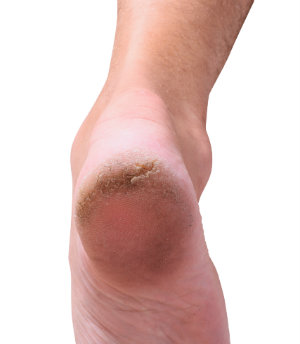 The medical condition known as cracked heels, is an ailment many patients suffer from. The symptoms that are most often associated with cracked heels can include skin that is dry and thick on the outside of the heels and deep cracks or fissures in that area. Diabetic patients may experience cracked heels as a result of a loss of feeling which may accompany this condition. This can possibly lead to bleeding and an infection. Some of the reasons cracked heels may develop can include being overweight, standing for extended periods of time throughout the day, or from wearing shoes that have an open back. Mild relief may be obtained when the feet are soaked in warm water, followed by frequently using a good moisturizer. If you have this condition, and it is causing pain and discomfort, it is suggested that you consult with a podiatrist who can recommend proper treatment options.
The medical condition known as cracked heels, is an ailment many patients suffer from. The symptoms that are most often associated with cracked heels can include skin that is dry and thick on the outside of the heels and deep cracks or fissures in that area. Diabetic patients may experience cracked heels as a result of a loss of feeling which may accompany this condition. This can possibly lead to bleeding and an infection. Some of the reasons cracked heels may develop can include being overweight, standing for extended periods of time throughout the day, or from wearing shoes that have an open back. Mild relief may be obtained when the feet are soaked in warm water, followed by frequently using a good moisturizer. If you have this condition, and it is causing pain and discomfort, it is suggested that you consult with a podiatrist who can recommend proper treatment options.
If the skin on your feet starts to crack, you may want to see a podiatrist to find treatment. If you have any concerns, contact James P. Huish, DPM from Arizona. Our doctors can provide the care you need to keep you pain-free and on your feet.
Cracked Heels
It is important to moisturize your cracked heels in order to prevent pain, bleeding, and infection. The reason cracked heels form is because the skin on the foot is too dry to support the immense pressure placed on them. When the foot expands, the dry skin on the foot begins to split.
Ways to Help Heal Them
- Invest in a good foot cream
- Try Using Petroleum Jelly
- Ease up on Soaps
- Drink Plenty of Water
Ways to Prevent Cracked Heels
- Moisturize After Showering
- Skip a Shower
- Keep Shower Water Lukewarm
- Don’t Scrub Your Feet
If you are unsure how to proceed in treating cracked heels, seek guidance from a podiatrist. Your doctor will help you with any questions or information you may need.
If you have any questions, please feel free to contact our office located in Safford and Sierra Vista, AZ . We offer the newest diagnostic and treatment technologies for all your foot care needs.
